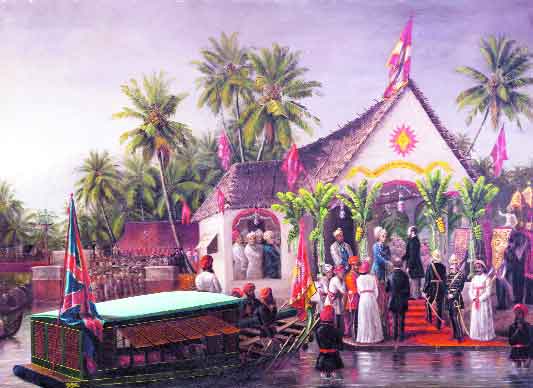An 1881 oil on canvas painting that came up for sale recently, has got it all – history, legend and the tale of Raja Ravi Varma. Story by Uma Nair
Amidst a range of artworks at the Saffron Sale, one painting, which was the cynosure of all viewers and art aficionados, was from the Income Tax department, Lot 13 — Nirav Modi’s Raja Ravi Varma. The 1881 oil on canvas represented history, legend and the royal lineage of the Maharaja of Travancore.
Replete with tropical elements, royal bodyguards standing in knee-deep water with a houseboat, the scene was epic. The rare oil painting illustrated the welcoming of the third Duke of Buckingham and Chandos, Richard Temple-Grenville, on his official visit to Trivandrum, a Princely state in southern India in 1880.
Temple-Grenville was the Governor General of Madras (1875-1880). In the artwork, Visakham Thirunal, the younger brother of the Maharaja Ayilyom Thirunal of Travancore, is welcoming the Duke, who is accompanied by his aide-de-camp and a few British army officers. Raja Ravi Varma was invited to document this historical event, and to paint “the moment when Buckingham alighted from the splendid barge, which must have undoubtedly brought him through the waterways of Kerala,” noted the sale.
The Maharaja is seen standing behind his brother in the building which bears the image of a conch shell, the symbol of the state of Travancore, as well as a welcoming banner for the Duke. It is likely that the ceremony depicted in the present lot took place at the Vallakadavu Boathouse, which was built in the 1820s and served as an important waterway hub for travel and cargo activity during the Travancore era. “Historical records reveal that the boattupura, as it is known to the locales, was used by the stately barges of the Travancore kings. The royal parties which went picnicking in the Veli Lake used to set sail from the boathouse. The priests, scholars and nobility who used to come to Thiruvananthapuram from far and near, used to alight here,” wrote T Nandakumar in 2004.
According to Erwin Neumayer and Christine Schelberger, during the Duke’s visit to Travancore, he was eager to meet Ravi Varma, a fact that made the Maharaja jealous. This visit ultimately turned out to be disastrous for the painter. “When the Duke met Ravi Varma in the presence of the king, he asked him to sit with them, which, according to the custom of the land was unthinkable. Ravi Varma declined to sit in the presence of the king and the three, the governor, the king, and the painter, remained standing while talking. Ravi Varma knew that he was now out of favour with the king and left Trivandrum never to come back during the lifetime of the king.” (Erwin Neumayer and Christine Schelberger eds., Raja Ravi Varma, Portrait of an Artist: The Diary of C Raja Raja Varma, New Delhi: Oxford University Press, 2005, p. 300)
Upon completion, the present lot was gifted to the Duke as a token of appreciation. After his death, the painting passed on to his eldest daughter Baroness Kinloss. In the 1920s, it changed hands and became a part of Castle House, Buckingham, the offices of Buckinghamshire County Council and remained there until 1974, when a private collector acquired it.The scene in all its perfection its intricate details and the allure of the cultural fabric of those times created a once in a lifetime panorama of panache and royal regalia.
Writer: Uma Nair
Courtesy: The Pioneer








 OpinionExpress.In
OpinionExpress.In















Comments (0)